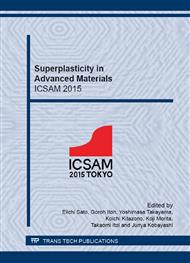[1]
Musin F, Kaibyshev R, Motohashi Y, et al., High strain rate superplasticity in a commercial Al–Mg–Sc alloy, Scripta Materialia, 2004, 50(4): 511-516.
DOI: 10.1016/j.scriptamat.2003.10.021
Google Scholar
[2]
Park K T, Lee H J, Lee C S, et al., Effect of ECAP strain on deformation behavior at low temperature superplastic regime of ultrafine grained 5083 Al alloy fabricated by ECAP, Materials Transactions, 2004, 45(3): 958-963.
DOI: 10.2320/matertrans.45.958
Google Scholar
[3]
Kaibyshev R, Sakai T, Nikulin I, et al., Superplasticity in a 7055 aluminum alloy subjected to intense plastic deformation, Materials science and technology, 2003, 19(11): 1491-1497.
DOI: 10.1179/026708303225008167
Google Scholar
[4]
Tsuji N, Ito Y, Saito Y, et al., Strength and ductility of ultrafine grained aluminum and iron produced by ARB and annealing, Scripta Materialia, 2002, 47(12): 893-899.
DOI: 10.1016/s1359-6462(02)00282-8
Google Scholar
[5]
Noda M, Hirohashi M, Funami K, Low temperature superplasticity and its deformation mechanism in grain refinement of Al-Mg alloy by multi-axial alternative forging, Materials Transactions, 2003, 44(11): 2288-2297.
DOI: 10.2320/matertrans.44.2288
Google Scholar
[6]
Mishra R S, Mahoney M W, McFadden S X, et al., High strain rate superplasticity in a friction stir processed 7075 Al alloy, Scripta Materialia, 1999, 42(2): 163-168.
DOI: 10.1016/s1359-6462(99)00329-2
Google Scholar
[7]
Charit I, Mishra R S, High strain rate superplasticity in a commercial 2024 Al alloy via friction stir processing, Materials Science and Engineering: A, 2003, 359(1): 290-296.
DOI: 10.1016/s0921-5093(03)00367-8
Google Scholar
[8]
Liu F C, Xiao B L, Wang K, et al., Investigation of superplasticity in friction stir processed 2219Al alloy, Materials Science and Engineering: A, 2010, 527(16): 4191-4196.
DOI: 10.1016/j.msea.2010.03.065
Google Scholar
[9]
Yadav D, Bauri R, Effect of friction stir processing on microstructure and mechanical properties of aluminium, Materials Science and Engineering: A, 2012, 539: 85-92.
DOI: 10.1016/j.msea.2012.01.055
Google Scholar
[10]
Jana S, Mishra R S, Baumann J A, et al., Effect of process parameters on abnormal grain growth during friction stir processing of a cast Al alloy, Materials Science and Engineering: A, 2010, 528(1): 189-199.
DOI: 10.1016/j.msea.2010.08.049
Google Scholar
[11]
Mahmoud T S, Mohamed S S, Improvement of microstructural, mechanical and tribological characteristics of A413 cast Al alloys using friction stir processing, Materials Science and Engineering: A, 2012, 558: 502-509.
DOI: 10.1016/j.msea.2012.08.036
Google Scholar
[12]
Charit I, Mishra R S, High strain rate superplasticity in a commercial 2024 Al alloy via friction stir processing, Materials Science and Engineering: A, 2003, 359(1): 290-296.
DOI: 10.1016/s0921-5093(03)00367-8
Google Scholar
[13]
Ma Z Y, Mishra R S, Mahoney M W, et al., High strain rate superplasticity in friction stir processed Al–Mg–Zr alloy, Materials Science and Engineering: A, 2003, 351(1): 148-153.
DOI: 10.1016/s0921-5093(02)00824-9
Google Scholar
[14]
Charit I, Mishra R S, Low temperature superplasticity in a friction-stir-processed ultrafine grained Al–Zn–Mg–Sc alloy, Acta Materialia, 2005, 53(15): 4211-4223.
DOI: 10.1016/j.actamat.2005.05.021
Google Scholar
[15]
Berbon P B, Bingel W H, Mishra R S, et al., Friction stir processing: a tool to homogenize nanocomposite aluminum alloys, Scripta Materialia, 2001, 44(1): 61-66.
DOI: 10.1016/s1359-6462(00)00578-9
Google Scholar
[16]
Zhang Z, Liu Y L, Chen J T, Effect of shoulder size on the temperature rise and the material deformation in friction stir welding, The International Journal of Advanced Manufacturing Technology, 2009, 45(9-10): 889-895.
DOI: 10.1007/s00170-009-2034-7
Google Scholar
[17]
Tang W, Guo X, McClure JC, Murr LE, J Mater Process Manuf Sci 1998; 7: 163.
Google Scholar
[18]
El Rayes M M, El Danaf E A, Soliman M S, High-temperature deformation and enhanced ductility of friction stir processed-7010 Aluminum Alloy, Materials & Design, 2011, 32(4): 1916-(1922).
DOI: 10.1016/j.matdes.2010.12.004
Google Scholar
[19]
Al-Fadhalah K J, Almazrouee A I, Aloraier A S, Microstructure and mechanical properties of multi-pass friction stir processed aluminum alloy 6063, Materials & Design, 2014, 53: 550-560.
DOI: 10.1016/j.matdes.2013.07.062
Google Scholar


